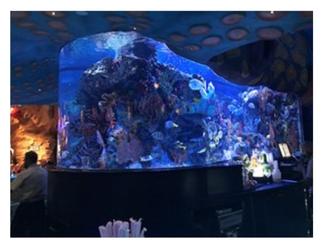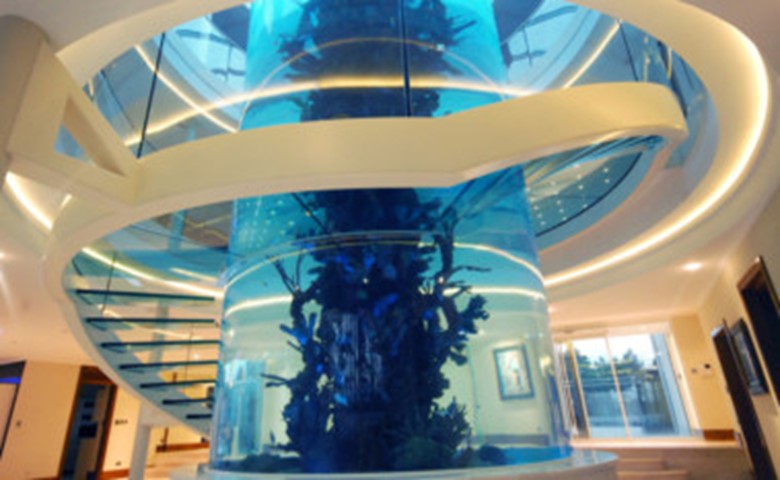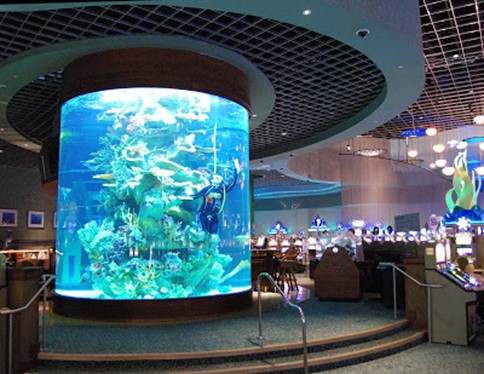A modified article that was originally published in Plastics Today July 13, 2018
The outstanding properties of PMMA have enabled the construction of massive aquariums, which have become some of the most popular attractions in the world. To prevent sudden, catastrophic failure, however, engineers need to have a thorough understanding of the material’s drawbacks.
Aquariums have become big attractions at some of the largest venues on the planet. Think of Walt Disney World; the largest mall in the world in Dubai; the AquaDom in Berlin, Germany, which has a 25-meter-tall cylindrical aquarium with a built-in elevator; or the Georgia Aquarium that holds 6.3 million gallons of water. If you are not familiar with these aquariums, I encourage you to step aside from this article and Google them so that you can appreciate their enormity.

The aquarium at the T-Rex restaurant at Walt Disney World in Orlando, FL, failed in 2014, when a vertical bonded seam opened instantaneously. Image courtesy Paul J. Gramann.
These aquariums hold thousands of exotic sea animals in extremely demanding environments, all the while putting the spectator inches away from this marine life. What is the single-most important element of the aquarium that makes it possible for these behemoths to exist? Plastic. Specifically, poly(methyl methacrylate) or PMMA, also known as acrylic and sometimes as plastic glass. Acrylic is ideal for this application. It possesses the mechanical properties, such as strength and stiffness, required to support the tremendous water pressure created in these ever-growing marine exhibits. Acrylic has other attributes that make it possible to meet the requirements of the ever increasing size and complexity, as engineers “push the envelope”:
- Acrylic is one of the clearest materials in the world;
- The weight of acrylic is less than half that of glass with up to 17x the impact strength;
- Acrylic can be heated and easily formed into curved shapes;
- Curved shapes, as well as other shapes, can be bonded together to make massive, continuous structures, such as cylinders and long wall expansions;
- It has relatively, low moisture absorption;
- Raw material and fabrication costs are low;
- Acrylic is more forgiving than glass if it is out of alignment or not perfectly supported.
Why acrylic aquariums may fail
Acrylic does not come without drawbacks. The engineer needs to have full knowledge and understanding of these drawbacks to successfully design, manufacture and assemble an aquarium that will stand and support aquatic life for years. To ensure longevity, the typical large aquarium is designed with a factor of safety of 11 to 12. This may seem high, but when one considers the implications if one of these large aquariums were to fail, and the sudden, catastrophic event that occurs when they do fail, it becomes more understandable and acceptable. Unfortunately, aquariums have failed for various reasons, leading to tremendous damage, huge monetary losses and, at times, complete loss of the aquatic life. There have been high-profile public aquarium failures, which typically involve huge aquariums, as well as private aquarium failures that range from several hundred to thousands of gallons of water loss. Some common reasons why acrylic aquariums can fail include:
- Poor bonding of acrylic panels creating a weak seam;
- Improper installation;
- Poor manufacturing of the acrylic panels, resulting in inferior strength and stiffness;
- Residual stress molded or formed into the panel during manufacturing;
- Introduction of large gouges or notches that can significantly increase stress in the panel.
Unfortunately, these issues commonly do not reveal themselves during inspection, assembly or the initial setup stages. Further, when the actual failure event does occur, which is typically months to years after installation, it is quick and catastrophic. The seam or crack opens nearly instantaneously without warning. The phenomenon behind this is called creep rupture—the disentanglement of the molecules of plastic over time, at a stress level significantly below the yield strength—yes, below the yield strength—of the plastic.

This three-story aquarium collapsed when two vertical seams opened unexpectedly. Image: The Sun, U.K.
Here is a sampling of some high profile, acrylic aquariums that have failed.
3-Story Tall in Private Residence in Scotland: This 10 foot diameter aquarium was reported to be the largest private aquarium in the world. The aquarium was in Scotland’s most expensive house overlooking Glenegles’ famous Queen’s golf course. The aquarium failed catastrophically when two seams opened. Over 2400 prized fish perished in the collapse.
Orient Shopping Center, Shanghai: This aquarium failed two years after installation, injuring 15 people and killing several sharks and turtles. The tank was constructed with 15-cm (5.9-in.) thick acrylic panels to hold 33 tons of water. The tank failed catastrophically without warning on Dec. 27, 2012.
Gulfstream Casino, Hallandale Beach, FL: The14-ft-diameter x 14-ft-high cylindrical aquarium opened at a fabricated (bonded) seam. The acrylic panels were 3 in. thick. A seam opened, instantaneously releasing thousands of gallons of water. After the event occurred, a quick thinking maintenance person stuffed the crack with cloth napkins saving all the aquatic life, except for one shark. This failure was the result of poor bonding of a vertical seam during manufacturing. Over time, this seam opened slightly by crazing, creating a stress concentration, which led to the catastrophic event.
Dubai Mall (World’s Largest) Aquarium: Home to more than 33,000 fish, including 400 sharks and stingrays, the aquarium formed a crack on Feb. 25, 2010. The 2.5-million-gallon aquarium contains the world’s largest single piece of acrylic, measuring 2.5 ft in thickness. A crack formed at an interior viewing tunnel, resulting in a significant amount of water loss. The crack was quickly repaired and there was no loss of aquatic life.
Mazatlán, Mexico: A large crack formed instantaneously in a 3-in.-thick curved overhead viewing panel on Feb. 3, 2017, shortly after the aquarium had closed for the day. The 1.2- million-gallon aquarium housed 13 large sharks at the time of the failure. The crack released over three quarters of the water in the aquarium, allowing for the safe removal of the sharks. This crack initiated at a large gouge mark at the exterior of the tank.
T-Rex, Walt Disney World, Orlando, FL: On March 17, 2014, just as dinner was being served at the T-Rex restaurant at Walt Disney World, a vertical bonded seam opened instantaneously in a large cylindrical aquarium. The aquarium was located adjacent to dining tables resulting in a number of people becoming drenched. The opening was approximately three feet long, giving employees time to transfer fish to other aquariums located on the grounds.

A large vertical crack formed at a seam in this aquarium at the Gulfstream Casino. Image: Living Color Aquariums.
Preventing catastrophic failure
Acrylic is an excellent material for both small, large and gargantuan-sized aquariums. This type of plastic has the appropriate mechanical properties, clarity, design and manufacturing freedom required for these aquariums to perform without fail for 20 or more years. However, without special attention given to its creep properties, manufacturing quality and care during installation and maintenance, sudden,
catastrophic failure can result. Acrylic is used in many other applications and industries, where the concepts discussed in this article are valid. These include aerospace, transportation, medical technology, construction, lighting and optics.
